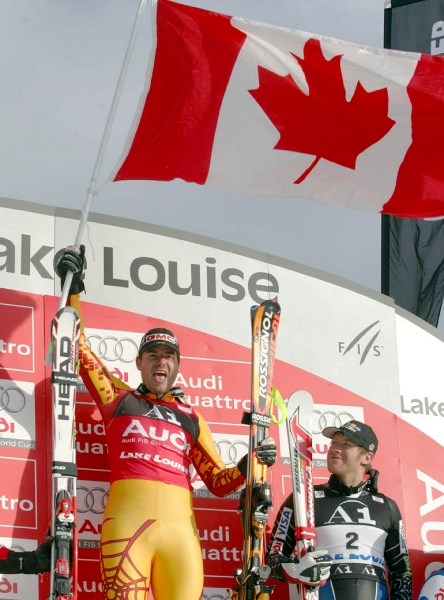LAKE LOUISE – Perhaps for the final time, the eyes of the world will be on Lake Louise as the alpine world cup gets underway over the next two weeks.
For more than four decades, the sport’s top stars have made global news in the iconic Canadian ski village and helped put Lake Louise on the map.
One of those headliners being retired Jan Hudec, a charismatic fan-favourite on the slopes, who only had to travel a stone's throw away for the world cup races. Winning downhill gold in Lake Louise in 2007, the Alberta-raised Hudec is perhaps the greatest performing Canadian at The Lake, and is known for having luck on his side.
“Lake Louise, in general, had a pretty big impact on my life,” said Hudec, who now lives in Czech Republic. “It was a special treat to race in Lake Louise, and made a huge impression on me as a skier.”
At the 2014 Winter Olympics in Sochi, headlines went wild after Hudec won bronze in the super-G and later revealed a lucky loonie, a golden dollar coin, was buried at the finish line beneath the snow.
People fell for Hudec’s goofy personality and his story of hidden treasures that helped propel the friendly skier to his only Olympic medal. However, it’s not the first time buried gold had given Hudec an edge.
Seven years before the famed Sochi loonie story broke, Hudec was dealing with heaps of injuries. Unfortunately, injuries plagued one of the original “Canadian Cowboys” throughout his long and storied career.
A staple at the start of the world cup calendar in recent times, Lake Louise, the popular tourist destination in Banff National Park, has always been a special spot for Hudec and his family.
Born in Czech Republic, Hudec’s family moved to Red Deer in 1986. Seven years later, the ski family was in one of the top ski destinations in Canada: Banff.
“To have the first world cup of the season there, it’s awesome because it gives you a little piece of mind,” said Hudec. “For me especially, I felt I was at home in a comfortable environment and it’s so fun to ski for friends and family.”
A unique aspect of the Lake Louise world cup is the tight relationship between the Canadian athletes and its volunteers known as Sled Dogs. It takes an insane amount of volunteer hours to make the world cup run and the Sled Dogs are behind it all.
At the end of every world cup at The Lake, a big party is held for the Sled Dogs where the athletes would join and thank them for their hard work.
“I think that was one thing that was always really special about that race, we got to connect with them,” said Hudec. “I think that tied it all together always was we had a really great relationship with the volunteers, the Sled Dogs of Lake Louise.”
Hudec came into the start of the 2007 season injury-free and ready to go.
Unknown to most, the Sled Dogs and timing crew got together and quietly buried a loonie at the finish line under the snow. The idea came from the 2002 Winter Olympics in Salt Lake City, where the Zamboni driver, a Canadian, froze a loonie at centre ice. Both Canadian men and women hockey teams won gold.
On the top of the hill in the very first race, Hudec had the No. 5 bib in the winner takes all downhill. Jumping out of the start gate, he rocketed down the home course at a time of 1:42.79, becoming the first Canadian man to win the Lake Louise downhill.
The gold was the first of five world cup medals Hudec won in his ski career. But coming back from injury, and to do it at home, this particular gold was special.
“[The Sled Dogs] later dug the loonie up and presented it to me with the Canadian flag, so I think that was certainly one of the coolest memories I have at Lake Louise,” he said.
The coin is in Calgary, safe with Hudec’s mother.
Seven years after that day in Lake Louise, Hudec buried a loonie under the snow at the finish line in Sochi. He would later win a bronze medal, snapping a 20-year drought for Canadians skiers medalling at the Games.
Reflecting on the Lake Louise world cups, a spot that has given Hudec much joy, he thinks one of its biggest legacies will be the volunteers.
“It’s an early season race that they always pulled it off,” he said. “Even if there wasn’t even any snow on snow control day, they always pulled it off. I think it will go down as that race that everyone loved. The volunteers and course crew are just the icing on the cake.”
In Czech Republic, Hudec has taken his skills from the hills to the online world where his start-up company PandaHAUS, a social media app connects athletes through mentorship, sponsorship and providing resources athletes need to succeed in sport. Part of the app would allow athletes to create their own NFTs and sell them.
"I didn't want a charity or foundation," said Hudec. "I wanted an idea that really changed peoples lives and actually was a hands-on approach."
LAKE LOUISE WORLD CUP BEGINS
The men's downhill and super-G races start Nov. 25-27 for the men, and Dec. 2-4 for women.
The men's races feature the rising stars of the Canadian speed team, which includes James Crawford, bronze medallist in alpine combined at the Beijing Games.




